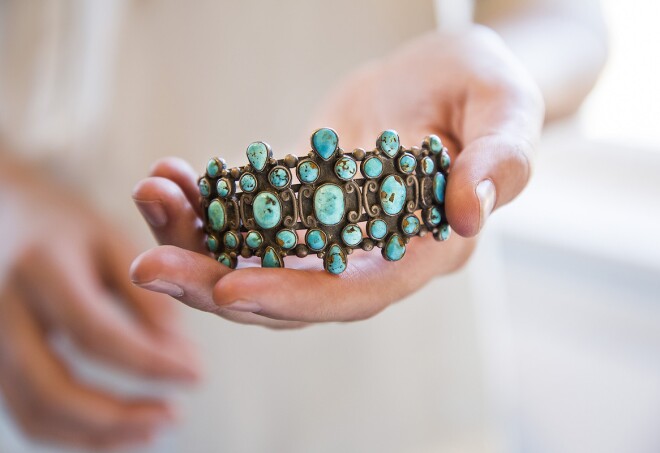When most people look at a piece of turquoise, they see a pretty blue stone. The people of New Mexico see water, sky, bountiful harvests, and a source of health and protection. Turquoise has been a valuable stone—in jewelry, for ceremonial purposes, and as an object of trade—for more than a thousand years. Many works of art incorporating turquoise are on permanent display in New Mexico, at institutions like the Museum of Indian Arts & Culture in Santa Fe. You can also, however, see (and touch) them at street festivals and markets along with weaving, pottery, silverwork, Kachina dolls, and more. You may even decide to take a bit of New Mexico home with you.
More Recommendations
Precious Stone
When most people look at a piece of turquoise, they see a pretty blue stone. The people of New Mexico see water, sky, bountiful harvests, and a source of health and protection. Turquoise has been a valuable stone—in jewelry, for ceremonial purposes, and as an object of trade—for more than a thousand years. Many works of art incorporating turquoise are on permanent display in New Mexico, at institutions like the Museum of Indian Arts & Culture in Santa Fe. You can also, however, see (and touch) them at street festivals and markets along with weaving, pottery, silverwork, Kachina dolls, and more. You may even decide to take a bit of New Mexico home with you.
Turquoise, Water, Sky
Did you know… turquoise is created by the pressure of millennia on copper, aluminum, and iron deposited by rain where water is scarce? The more copper, the bluer the stone. Turquoise, Water, Sky tells the story of turquoise, how it is formed, where it’s been found (Egypt, Iraq, Tibet), how Native Americans interpret the stone, and how contemporary artists are adapting traditional methods. Among Native Americans, turquoise is treasured for its color and what it represents – water which is scarce, and the sky, which is vast, whose color is reflected in water, and which brings water through rain. Fetishes (small animal carvings) and animal motifs also represent water and sky. Dragonflies, turtles, frogs, water moccasins, and shells are only found near places with water. Birds and butterflies represent the sky. Each carries its own mystique and power. Turquoise is believed to be imbued with the power to heal and protect. Navajo pieces on display showcase skill in silverwork. Zuni inlay on silver is sometimes layered on Navajo silver, oxidized to provide a black background. Experts determine the provenance of a stone based upon color, texture and grain. Sadly, most U.S. mines have been depleted. Much of the new turquoise on the market today is from China. Turquoise, Water, Sky runs from April 2014 through April 2016. (Photos above were provided with permission from the Museum.) Artist talks, field trips to mines, and more will be announced for summer and fall.
Native Arts and Culture
You’ll be tempted by turquoise everywhere you go in Santa Fe, but head up to the Museum of Indian Arts and Culture on Museum Hill and you’ll learn more about its significance. The current exhibit, Turquoise, Water, Sky: The Stone and Its Meaning now on display through May 2016, recounts the long and fascinating history of this sacred stone and its use in Native American jewelry. Even after the exhibit ends, you’ll still be able to learn about Native American jewelry here (as well as be tempted to buy some of the beautiful pieces for sale in the museum’s well-stocked shop). But the museum goes beyond jewelry to include all forms of Indian arts, pottery, carvings, textiles, and other crafts. This unique museum puts the pieces in their Native American context, providing visitors with insights into the beauty of the design, as well as the cultures of their creators.























